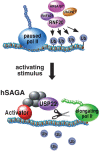Histone H2B ubiquitination: the cancer connection
- PMID: 18923072
- PMCID: PMC2751279
- DOI: 10.1101/gad.1732108
Histone H2B ubiquitination: the cancer connection
Abstract
Post-translational modifications of histones play a critical role in gene expression control. Ultimately, cancer is a disease of aberrant gene expression. Accordingly, several histone-modifying enzymes have been described as proto-oncogenes or tumor suppressors. Recent reports, including one from Shema and colleagues (pp. 2664- 2676) in the October 1, 2008, issue of Genes and Development, indicate that deregulation of histone H2B monoubiquitination may contribute to cancer development.
Figures

Comment on
-
The histone H2B-specific ubiquitin ligase RNF20/hBRE1 acts as a putative tumor suppressor through selective regulation of gene expression.Genes Dev. 2008 Oct 1;22(19):2664-76. doi: 10.1101/gad.1703008. Genes Dev. 2008. PMID: 18832071 Free PMC article.
Similar articles
-
Mechanism of Cross-talk between H2B Ubiquitination and H3 Methylation by Dot1L.Cell. 2019 Mar 7;176(6):1490-1501.e12. doi: 10.1016/j.cell.2019.02.002. Epub 2019 Feb 11. Cell. 2019. PMID: 30765112 Free PMC article.
-
Histone modifying enzymes and cancer: going beyond histones.J Cell Biochem. 2005 Dec 15;96(6):1137-48. doi: 10.1002/jcb.20615. J Cell Biochem. 2005. PMID: 16173079 Review.
-
E3-Independent Constitutive Monoubiquitination Complements Histone Methyltransferase Activity of SETDB1.Mol Cell. 2016 Jun 16;62(6):958-966. doi: 10.1016/j.molcel.2016.04.022. Epub 2016 May 26. Mol Cell. 2016. PMID: 27237050 Free PMC article.
-
Histone H2B monoubiquitination: roles to play in human malignancy.Endocr Relat Cancer. 2015 Feb;22(1):T19-33. doi: 10.1530/ERC-14-0185. Epub 2014 Jun 2. Endocr Relat Cancer. 2015. PMID: 24891457 Review.
-
The Bur1/Bur2 complex is required for histone H2B monoubiquitination by Rad6/Bre1 and histone methylation by COMPASS.Mol Cell. 2005 Nov 23;20(4):589-99. doi: 10.1016/j.molcel.2005.09.010. Mol Cell. 2005. PMID: 16307922
Cited by
-
Restoring MLL reactivates latent tumor suppression-mediated vulnerability to proteasome inhibitors.Oncogene. 2020 Sep;39(36):5888-5901. doi: 10.1038/s41388-020-01408-7. Epub 2020 Jul 30. Oncogene. 2020. PMID: 32733069 Free PMC article.
-
Atypical plant homeodomain of UBR7 functions as an H2BK120Ub ligase and breast tumor suppressor.Nat Commun. 2019 Mar 28;10(1):1398. doi: 10.1038/s41467-019-08986-5. Nat Commun. 2019. PMID: 30923315 Free PMC article.
-
MUSIC: identification of enriched regions in ChIP-Seq experiments using a mappability-corrected multiscale signal processing framework.Genome Biol. 2014;15(10):474. doi: 10.1186/s13059-014-0474-3. Genome Biol. 2014. PMID: 25292436 Free PMC article.
-
Biosynthetic enzyme GMP synthetase cooperates with ubiquitin-specific protease 7 in transcriptional regulation of ecdysteroid target genes.Mol Cell Biol. 2010 Feb;30(3):736-44. doi: 10.1128/MCB.01121-09. Epub 2009 Dec 7. Mol Cell Biol. 2010. PMID: 19995917 Free PMC article.
-
Development of Electrochemical Aptasensor for Lung Cancer Diagnostics in Human Blood.Sensors (Basel). 2021 Nov 25;21(23):7851. doi: 10.3390/s21237851. Sensors (Basel). 2021. PMID: 34883850 Free PMC article.
References
-
- Ahn S.H., Kim M., Buratowski S. Phosphorylation of serine 2 within the RNA polymerase II C-terminal domain couples transcription and 3′ end processing. Mol. Cell. 2004;13:67–76. - PubMed
-
- Boritzki T.J., Jackson R.C., Morris H.P., Weber G. Guanosine-5′-phosphate synthetase and guanosine-5′-phosphate kinase in rat hepatomas and kidney tumors. Biochim. Biophys. Acta. 1981;658:102–110. - PubMed
-
- Bracken A.P., Kleine-Kohlbrecher D., Dietrich N., Pasini D., Gargiulo G., Beekman C., Theilgaard-Monch K., Minucci S., Porse B.T., Marine J.C., et al. The Polycomb group proteins bind throughout the INK4A–ARF locus and are disassociated in senescent cells. Genes & Dev. 2007;21:525–530. - PMC - PubMed
-
- Briggs S.D., Xiao T., Sun Z.W., Caldwell J.A., Shabanowitz J., Hunt D.F., Allis C.D., Strahl B.D. Gene silencing: Trans-histone regulatory pathway in chromatin. Nature. 2002;418:498. - PubMed
Publication types
MeSH terms
Substances
Grants and funding
LinkOut - more resources
Full Text Sources
Other Literature Sources
Miscellaneous
